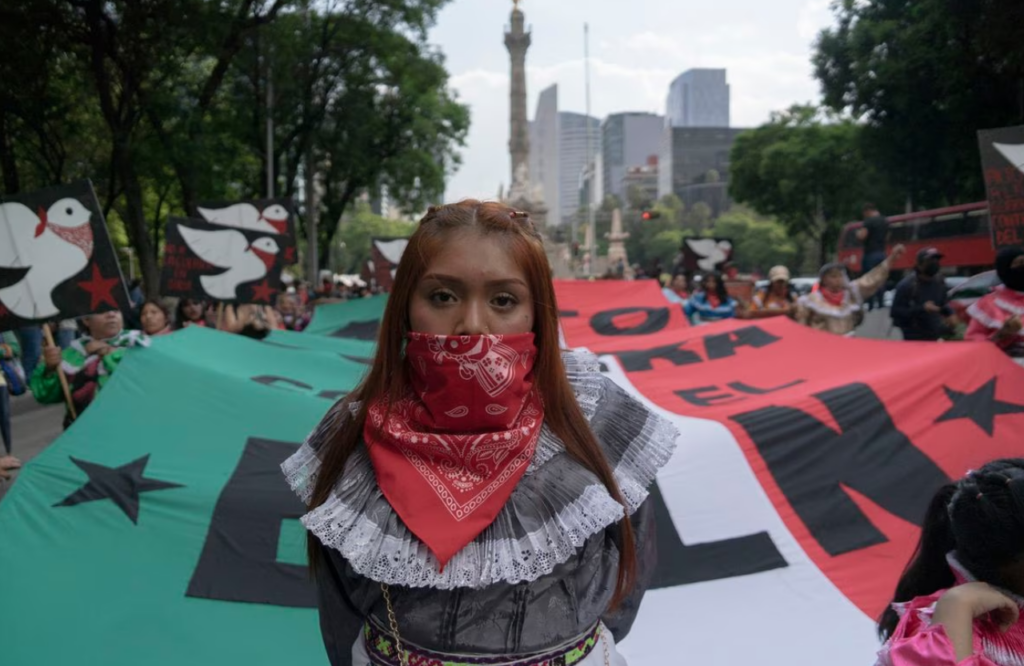
Photo@Carlos López (EFE)
The tightening of narco control in key areas of the border and the Lacandon Jungle represents the umpteenth escalation in the armed conflict of a seriously wounded state that threatens to explode.
The armed men burst into the town to announce that from that moment on they were the law. They assaulted the rural police, surrounded the commissioner’s house to leave no room for doubt as to who was in charge, and when they left, they left behind a message: “From now on we are taking control of the town and the region.” They said they were members of the Sinaloa Cartel, hitmen of Ismael ”El Mayo” Zambada. The community of Nueva Palestina revolted despite the threats. On September 6th, they sent a public letter to the President of the Government, Andrés Manuel López Obrador, begging for military intervention, for the State to defend them from the commandos. The gauntlet has been thrown down and one thing is clear: drug trafficking has become strong in the Lacandon Jungle, the symbolic heart of Chiapas.
The clichés, the common places, are wildcards that help, but fall short. For example: Chiapas is a time bomb, a pressure cooker, the straw that will break the camel’s back, a spiral of violence, a powder keg — “on the verge of civil war,” says the Zapatista Army of National Liberation (EZLN) — . Formulas used ad nauseam during the last three decades that, however, remain true. The reality is that the poorest state in Mexico is all that and much more: a latent armed conflict for the last 30 years, an amalgamation of paramilitaries, soldiers, guerrillas and self-defense groups that, in recent times, has seen the situation worsen with the entry into the scene of organized crime. To understand it, it is an arsenal loaded to the brim with a thousand and one types of gunpowder, surrounded by a fire that, instead of going out, is becoming more and more fueled. The explosion seems inevitable. And it’s getting closer.
The Sinaloa Cartel and the Jalisco New Generation Cartel have found a new vein to exploit in the border region: a porous territory, fertile for illicit businesses, with three major arteries for drug trafficking that cross the Lacandon, Frontera Comalapa and the Pacific coast. The possibility of doing business is immense in the heat of megaprojects such as the Mayan Train, tourism and the speculation that they bring hand in hand. The breeding ground is set. The destruction of the social fabric caused by the maelstrom of weapons that is devouring the region is increasingly pressing, and, as always, it is civil society that is paying the most, especially women and indigenous communities, according to all reports, analyses, testimonies from specialists and people who suffer from it themselves. Massacres, femicides, kidnappings, sexual violence, disappearances, forced displacements. The repertoire of horror is huge.
The Escalation of a Covert War
Diana Itzu Luna has been living in Chiapas for 12 years and studying these dynamics. She is currently doing a stay at the Center for Research and Higher Studies in Social Anthropology (CIESAS): “We are seeing an intensification of organized crime in the last three years: from the arrival of armed commandos in armored vehicles that promote kidnappings, car thefts, protection rackets. At the same time, femicides are increasing, there is a lot of depression and suicides, death and daily disappearances of young people. In the communities there is an increase in [consumption of] alcohol, drugs, weapons and prostitution.”
Experts point out that the arrival of the Mayan Train, mining, tourism and exploitation of the region’s natural resources projects, coincides with the rise of the mafias. “All this is going to lead to greater consumption and here organized crime comes in,” says Itzu Luna. “There is control of the territories, obviously where there is water, oil, minerals, but we also have to understand how the political class becomes part of organized crime. Here we see no difference between politicians and drug traffickers”, she explains.
As Mario Ortega Gutiérrez, coordinator of the systematization and advocacy area of the Fray Bartolomé de las Casas Center for Human Rights (Frayba), says, it is very difficult to demonstrate with evidence that the opportunities to get rich offered by megaprojects like the Mayan Train are what attracts organized crime, “but it always coincides.” “We also don’t want to think that it is the only thing. We understand that at the national level there is still a cartel dispute and we do not know what ruptures have occurred so that Chiapas, which historically had not entered into the situation of the rest of the country, has now.”
Chiapas has a great history of campesino organization, assemblies and protests. A strong associative movement that, for the expert, helps explain the resistance that had existed to the incursion of organized crime in the region: “Possibly, it has a lot to do with the fact that the cartels had not known how to enter due to the strong reluctance and the networked society, and now they have been able to through social control.”
The main cartels that operate in the region, Sinaloa and Jalisco New Generation, as well as dozens of regional groups, use three main arteries to traffic, explains Ortega Gutiérrez. The central one: from Frontera Comalapa to San Cristóbal de las Casas. “This has been the route so far most in dispute between the two large cartels, with a red light on the border, but the conflict tends to spread.” The north, which begins in the Lacandon Jungle, one of the places where the situation is worsening: “Historically, since the 70s, it has been documented that it is an area where there are various clandestine drug trafficking routes, where most of the drugs arrive and other resources of organized crime in small planes, and the route follows an entire highway that crosses the northern area of Chiapas until reaching Palenque, Tabasco, Veracruz….” The third way is along the Pacific coast.

Remilitarization and Paramilitarism
There is no easy answer to a conflict with a thousand facets. For example: the military intervention requested by the Lacandon community in its public letter is a measure that many other areas of the state reject. Often, critics say, the presence of soldiers is part of the problem, not the solution. “What we have seen is that communities often have a dilemma when it comes to requesting security. The very strong psychosocial impact of the militarism of the 90s, with many violations of human rights, is in the collective imagination. It is very respectable that communities demand the presence of public security as a desperate measure against violence, we do not doubt that it can have an immediate effect, but it does not solve it in the long term”, explains Ortega Gutiérrez.
On January 1st, 1994, the same day that the Free Trade Agreement (NAFTA) came into force, the EZLN, formed by thousands of farmers from Chiapas, took up arms and put the Government of Carlos Salinas de Gortari in check. They sought to put an end to the lacerating inequality suffered by indigenous people in Mexico. Over the years they gained influence, becoming the bête noire of the Mexican State, a solid opposition outside Congress and a kind of beacon for the global left. Although they have now spent years following a strategy of silence, they continue to be spied on, monitored and surrounded by military intelligence and attacked by paramilitary groups.
The Zapatista uprising was followed by the first process of militarization in Chiapas. That is why many experts now prefer to talk about a remilitarization, a reinforcement of what already existed. “Since I arrived in Chiapas, especially due to the context of the Zapatista uprising in 1994, I found a militarized state. It has been a constant for the last 30 years”, says Itzu Luna. The Government unleashed a counterinsurgency strategy to isolate and reduce the EZLN communities, which have since lived in autonomous regions, outside the Mexican authorities.
In the heat of the counterinsurgency, numerous paramilitary groups with dark connections emerged. The emblematic case, the one that remains like an open wound in the memory of the region, is Acteal: on March 22nd, 1997, a death squad murdered 45 people in cold blood in a church, including 18 children. Two years ago, the López Obrador Government recognized that the hand of the State was behind the massacre and stated that the hitmen belonged to “paramilitary groups with the complacency of the authorities.”
“Documenting Army headquarters [in Chiapas] always leads you to paramilitary groups, trained and armed by them”, says Itzu Luna. “In the 2000s, the State’s option was the corporatization of paramilitary organizations that later played this dirty game of war of attrition”, agrees Ortega Gutiérrez. Currently, the EZLN strongholds continue to suffer a constant paramilitary siege. “The situation wants to push the Zapatistas to use weapons”, warns the researcher.
There was never disarmament, not even after the EZLN and the Government signed a kind of symbolic, but not practical, peace with the San Andrés agreements of 1996. “Chiapas has not had a process of transition to peace nor a truth [commission] for all the crimes that were committed. The spiral of violence is obviously not new, the element of organized crime is adding to it and making it much more complex,” says the Frayba researcher. The expert adds one more factor: that currently the old paramilitary groups and the new cartels are beginning to link up to maintain control.
For Frayba, remilitarizing is not the solution to the problem: “Despite the presence of the military and the National Guard, criminal groups are mobilizing right under their noses. We are clear that it is not the answer. We believe that the strongest option is from below: communities have the possibility through peaceful alternatives to shield themselves, understanding that this war for control is not only armed, it is also cultural. We must rebuild and strengthen the social fabric.”

Photo@Carlos López (EFE)
Original article by Carlos Santos Cid at https://elpais.com/mexico/2023-09-17/chiapas-nueva-sangre-viejas-guerras.html
Translated by Schools for Chiapas.
